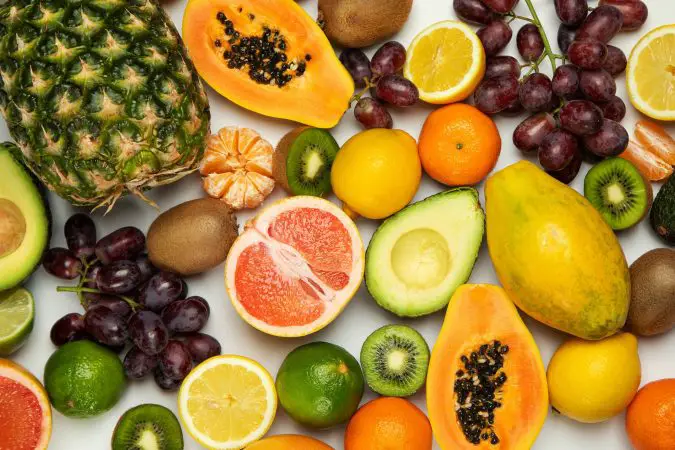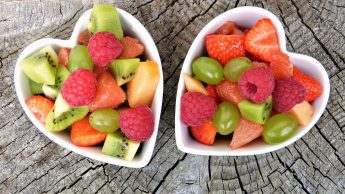Since you were young, you have known that fruit is one of the healthiest foods you can eat, in addition to vegetables. You probably looked forward to a sweet treat or a salty treat after your school days, such as a candy bar or potato chips. Perhaps your parents gave into that.
However, they likely taught you that fruit and vegetables were much better for you than candy or chips. Therefore, you would probably have fruit for dessert after dinner, making it a healthy dessert for you. You likely had fruit as a part of your breakfast as well.
You also may have learned that certain vegetables are technically fruits at a young age because they grow from plants into food with a shape which is the ovary, and it has seeds.
Examples of fruits that you believe are in the vegetable category are cucumbers, avocado, squash, tomatoes, eggplant, and peppers.
What Are The Different Types Of Fruits?
Did you know that fruits have classes as well? There are three fruit types which include the simple type, aggregate type, and multiple types. So, why not learn about these fruit categories and impress those you know that you are so knowledgeable about fruits.
There are different types of fruits and vegetables, find out more about them HERE.
Simple Fruit
Most of the fruit that you eat regularly is simple as they are fleshy. That also includes the fruits disguised as vegetables as well. There are four classifications of fruit that fall into the simple category as well. Let’s take a look at the four different subcategories of these simple fruits:
Berries
Berries are incredibly fleshy and juicy fruits and have seeds in the middle. Examples of berries are bananas, blueberries, grapes, and avocado, even though they are not juicy. The confusing thing is that blackberries and strawberries are technically not berries at all for this reason.
However, people call them berries because they go well with other berries the same way tomatoes go well with lettuce. That means the fruit, which is the tomato goes well with lettuce, which is a vegetable.
Drupes
When you think of drupes, you think of those fruits that have a hard concrete-like pit in the middle, such as nectarines, plums, peaches, and cherries. You would think that avocados would fall into this category, but it is a berry because of the layer of skin.
Pepos and Hesperidium
These are two subcategories within one: pepos and hesperidium, which you may think of as berries because they have many similarities. However, they are pretty different. Hesperidia fruits are citrus such as oranges, lime, lemon, and grapefruit because they have juicy flesh that has a tangy, bitter, sour flavor and a thick, bitter rind with some seeds spread through the flesh.
Oranges are the only hesperidium that is sweet. Pepos have thick and leather-like skin as they are in the melon category, such as watermelons, cantaloupe, honeydew, squash, and cucumber. They have plenty of flesh and seeds that are throughout the flesh.
Accessory
These fruits are known to be accessory fruits derived from a flower other than the ovary. Strawberries are an accessory fruit, as well as mulberries and figs. There is a specific accessory fruit known as pomes, such as pears and apples. Pomes usually come from trees.
Aggregate Fruits

If you have heard of the term aggregate fruits but you do not know what they mean, you are in luck, as you will find out now. These fruits consist of plenty of berries and drupes that derive from the same flower. In addition, you may find some aggregate fruits cross-over from the accessory fruits.
Therefore, they can be in both the aggregate and simple fruit categories. An example of that is the strawberry. Aggregate fruits also consist of a small plum, blackberries, raspberries, or tiny cherry, and that is because they have a little seed inside the bulb. Because raspberries and blackberries are so small, some people call them drupelets.
Collective Fruits
Multiple fruits are also known as collective fruits, and they are masses of fruit—a cluster of fruiting flowers known as inflorescence from these fruits. The flowers in the inflorescence create a fruit. It becomes a mass, also known as the infructescence, once the fruit matures. Examples of these fruits are pineapples, figs, the dosage orange, mulberry, breadfruit, and jackfruit.
These fruits that you may be most familiar with are mulberries, figs, and pineapples. However, mulberries and figs can be in the accessory-simple fruit classification as well.
Conclusion
You likely did not know that these fruits were classified‘ unless you are a botanist, nutritionist, or grocery store clerk. Perhaps you remember this from your high school biology courses as well.
However, now you know that several fruits go beyond knowing that some vegetables such as tomatoes, avocado, cucumber, and squash are fruit. If you plan to have a trivia night with some friends, you can even add this topic to the game.
You may be impressed that your friends know this fact, or you may have the opportunity to teach them about this fascinating fact about fruit!
Feel free to reach out to us in the comments. Check out our website for more insights on gardening.


